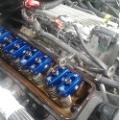i reflowed the board that was having trouble in the oven, and resoldered both ecms with some extra care and attention. now both are functioning, so eehack has dual test benches.
now we're cooking with fire. i can try all the crazy stuff i wanted to with the flash write routine.




 Reply With Quote
Reply With Quote


Bookmarks